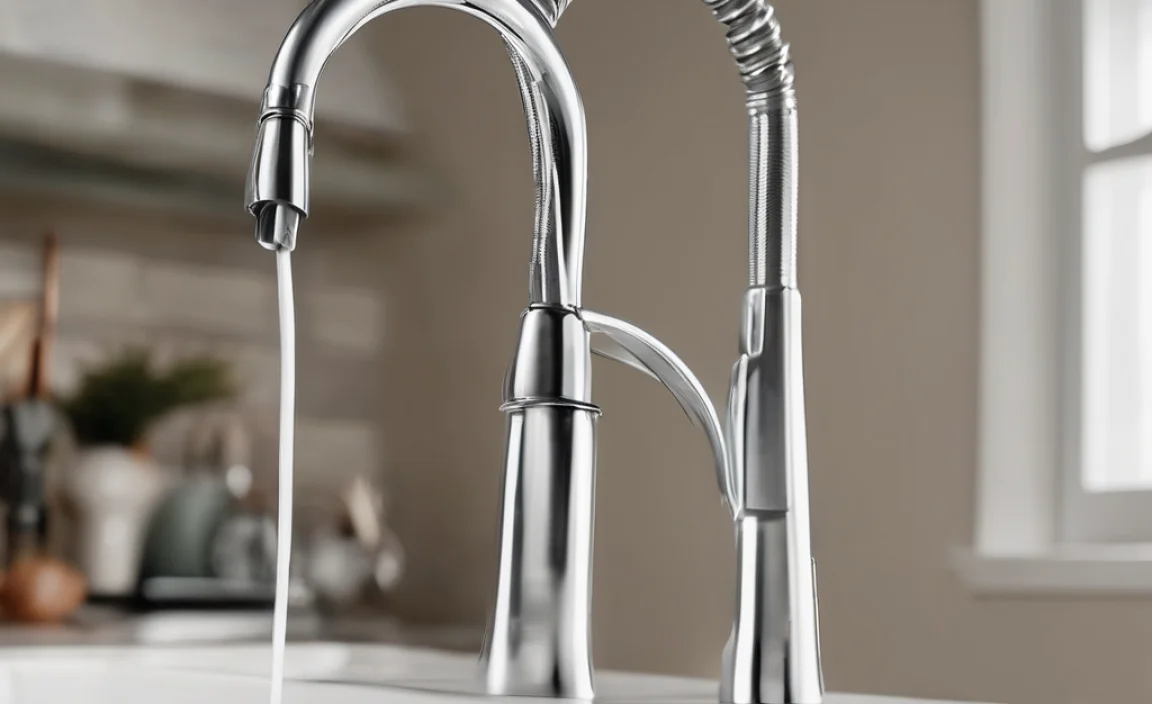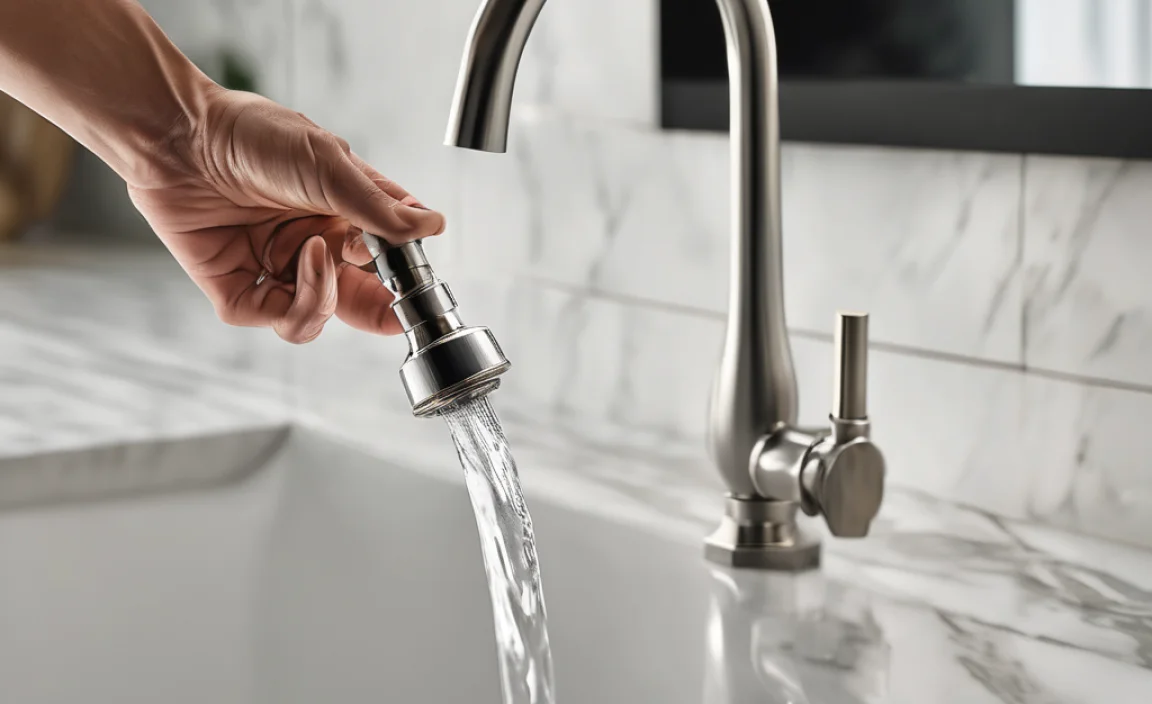Replacing a faucet stem is a simple fix that can stop annoying drips and save water. First, turn off the water supply. Then, remove the faucet handle and trim. Unscrew the old stem, take it to the hardware store to find an exact match, and install the new stem. Turn the water back on, and you’re done! This easy DIY project can save you money and prevent water waste.
Is your faucet dripping and driving you crazy? Don’t worry, you’re not alone! A leaky faucet is a common problem, and often the culprit is a worn-out faucet stem. The good news is that replacing a faucet stem is a straightforward DIY project that almost anyone can handle. You don’t need to be a plumbing expert. This guide will walk you through each step, making the process simple and stress-free. Soon, you’ll have a drip-free faucet and the satisfaction of fixing it yourself. Let’s get started!
Tools and Materials You’ll Need

Before you dive in, gather all the necessary tools and materials. Having everything on hand will make the job go smoothly.
- New Faucet Stem: The most important part! Bring your old stem to the hardware store to ensure you get an exact match.
- Screwdriver: Both Phillips and flathead screwdrivers might be needed.
- Adjustable Wrench: For loosening and tightening the stem.
- Penetrating Oil: Helps loosen stubborn parts.
- Plumber’s Grease: To lubricate the new stem.
- Towels or Rags: To protect the sink and clean up spills.
- Basin Wrench (Optional): If the faucet is hard to reach.
Step-by-Step Guide to Replacing a Faucet Stem

Follow these steps carefully, and you’ll have your new faucet stem installed in no time.
Step 1: Turn Off the Water Supply
This is the most crucial step! Locate the shut-off valves under the sink. There should be one for hot water and one for cold water. Turn both valves clockwise until they are completely closed. If you don’t have individual shut-off valves, you’ll need to turn off the main water supply to your house. The main valve is usually located in the basement, garage, or near the water meter. After shutting off the water, turn on the faucet to relieve any remaining pressure in the pipes.
Step 2: Protect the Sink
Place a towel or rag in the sink to protect it from scratches and dings. This will also help catch any small parts that might fall while you’re working.
Step 3: Remove the Faucet Handle
The faucet handle is usually held in place by a screw. Look for the screw on the top, front, or side of the handle. It might be hidden under a decorative cap. If there’s a cap, gently pry it off with a flathead screwdriver. Once you’ve located the screw, use the appropriate screwdriver (Phillips or flathead) to remove it. After removing the screw, gently pull the handle straight off the faucet. If the handle is stuck, try wiggling it gently or spraying some penetrating oil around the base.
Step 4: Remove the Faucet Trim or Escutcheon
The trim or escutcheon is the decorative piece that covers the faucet stem. It’s usually held in place by threads or a retaining nut. Unscrew the trim by hand, turning it counterclockwise. If it’s stuck, use an adjustable wrench to gently loosen it. Be careful not to scratch the finish. Some trims just pull off; check for a snap-on fitting.
Step 5: Loosen the Stem
Now you should see the faucet stem. Use an adjustable wrench to grip the stem and turn it counterclockwise to loosen it. If the stem is stuck, spray it with penetrating oil and let it sit for a few minutes before trying again. A basin wrench can be helpful if the faucet is in a tight spot.
Step 6: Remove the Old Stem
Once you’ve loosened the stem, you should be able to unscrew it the rest of the way by hand. As you remove the stem, be careful not to lose any small parts, such as washers or O-rings. Note the order in which these parts are assembled, as you’ll need to reassemble them in the same way on the new stem.
Step 7: Identify the Correct Replacement Stem
This is a crucial step. Take the old stem with you to your local hardware store or plumbing supply store. Compare it carefully to the new stems available, making sure the length, thread size, and shape are identical. Some stores might even have a catalog or computer system to help you find the exact match. Buying the correct stem will save you a lot of headaches later.
Step 8: Install the New Stem
Before installing the new stem, inspect it for any defects. Make sure all the washers and O-rings are in good condition and properly seated. Apply a small amount of plumber’s grease to the threads and the O-rings. This will help the stem turn smoothly and prevent leaks. Screw the new stem into the faucet body by hand, turning it clockwise. Once it’s snug, use the adjustable wrench to tighten it a little more. Be careful not to overtighten it, as this could damage the stem or the faucet body.
Step 9: Reassemble the Faucet
Now it’s time to put everything back together. Reinstall the trim or escutcheon, turning it clockwise until it’s snug. Then, reattach the faucet handle, making sure it’s properly aligned. Tighten the handle screw securely. Replace the decorative cap, if there was one.
Step 10: Turn the Water Back On
Slowly turn the water supply valves counterclockwise to turn the water back on. Check for leaks around the faucet stem and handle. If you see any leaks, tighten the stem or handle screw a little more. If the leaks persist, you may need to remove the stem and inspect the washers and O-rings. Make sure they are properly seated and in good condition.
Troubleshooting Common Issues

Sometimes, things don’t go exactly as planned. Here are some common issues you might encounter and how to solve them.
Problem: The Stem is Stuck
Solution: Apply penetrating oil and let it sit for 15-20 minutes. Use a basin wrench for extra leverage if needed.
Problem: The New Stem Leaks
Solution: Ensure all washers and O-rings are properly seated. Tighten the stem a bit more, but don’t overtighten. Consider using Teflon tape on the threads.
Problem: Can’t Find an Exact Match
Solution: Check online plumbing supply stores. Bring the old stem to multiple hardware stores for a wider selection. A universal stem kit might work as a temporary solution.
Choosing the Right Faucet Stem
Selecting the correct replacement faucet stem is essential for a successful repair. Here’s a breakdown to help you make the right choice:
| Type of Faucet | Stem Characteristics | How to Identify |
|---|---|---|
| Compression Faucet | Simple design, uses rubber washers | Has separate hot and cold handles; often the oldest type of faucet |
| Cartridge Faucet | Uses a cartridge to control water flow | Single handle that moves up/down and left/right |
| Ball Faucet | Uses a ball valve to control water flow | Single handle that pivots around a ball-shaped joint |
| Ceramic Disc Faucet | Uses ceramic discs for precise water control | Single lever with a wide cylindrical body |
Maintaining Your Faucet to Prevent Future Issues
Regular maintenance can prevent future faucet problems. Here are a few tips:
- Clean Regularly: Wipe down your faucets regularly to prevent mineral buildup.
- Lubricate: Periodically lubricate the faucet stems with plumber’s grease to keep them turning smoothly.
- Replace Washers: Replace worn washers and O-rings promptly to prevent leaks.
- Inspect: Check your faucets periodically for leaks or drips and address them promptly.
Cost Analysis: DIY vs. Hiring a Plumber
One of the biggest advantages of tackling this project yourself is the cost savings. Here’s a quick comparison:
| Option | Estimated Cost | Pros | Cons |
|---|---|---|---|
| DIY | $10 – $30 (for the stem and grease) | Significant cost savings, convenient, learn a new skill | Requires some basic tools and knowledge, potential for mistakes |
| Hiring a Plumber | $100 – $300+ | Professional expertise, guaranteed work, saves time and effort | Higher cost, scheduling may be required |
Advantages of Replacing the Faucet Stem Yourself
Why should you consider doing this yourself? Here are some compelling reasons:
- Save Money: Avoid expensive plumber fees.
- Gain a New Skill: Learn valuable DIY skills.
- Convenience: Fix the problem on your own schedule.
- Prevent Water Waste: Stop those annoying drips and save water.
Potential Pitfalls and How to Avoid Them
While replacing a faucet stem is generally straightforward, there are some potential pitfalls to watch out for:
- Stripped Screws: Use the correct size screwdriver and apply steady pressure.
- Overtightening: Tighten the stem and handle screws just enough to secure them, but not so much that you damage the parts.
- Incorrect Parts: Always double-check that you have the correct replacement stem before starting the installation.
- Water Damage: Make sure the water is completely turned off before you start working to prevent water damage.
Advanced Tips and Tricks
Here are a few extra tips to help you along the way:
- Take Pictures: Before you disassemble the faucet, take pictures of each step. This will help you remember how everything goes back together.
- Use Penetrating Oil: If any parts are stuck, don’t force them. Apply penetrating oil and let it sit for a few minutes before trying again.
- Have a Helper: If possible, have someone assist you. An extra pair of hands can be helpful for holding parts or providing light.
When to Call a Professional Plumber
While many faucet repairs are DIY-friendly, there are times when it’s best to call a professional plumber. Here are some situations where you should seek expert help:
- Extensive Corrosion: If the faucet is heavily corroded, it may be difficult to remove the stem without damaging the faucet body.
- Persistent Leaks: If you’ve tried replacing the stem and the faucet still leaks, there may be a more serious problem.
- No Shut-Off Valves: If you don’t have shut-off valves under the sink and you’re not comfortable turning off the main water supply, call a plumber.
- Complex Faucets: Some high-end or complex faucets may require specialized tools and knowledge to repair.
FAQ: Replacing a Faucet Stem
Here are some frequently asked questions about replacing faucet stems:
What is a faucet stem?
A faucet stem is the central component inside a faucet that controls the flow of water. It’s what you turn to turn the water on and off.
How do I know if my faucet stem needs replacing?
Common signs include constant dripping, difficulty turning the handle, or water leaking from around the handle.
Can I replace a faucet stem myself?
Yes, most homeowners can replace a faucet stem with basic tools and a little patience. Follow our step-by-step guide!
Where can I buy a replacement faucet stem?
You can find replacement faucet stems at most hardware stores, home improvement centers, and online plumbing supply stores.
How much does it cost to replace a faucet stem?
The cost of a replacement faucet stem typically ranges from $10 to $30, depending on the type of faucet and the brand of the stem.
Do I need any special tools to replace a faucet stem?
You’ll need a screwdriver, an adjustable wrench, and possibly some penetrating oil and plumber’s grease. A basin wrench can be helpful for hard-to-reach faucets.
How long does it take to replace a faucet stem?
Replacing a faucet stem usually takes about 30 minutes to an hour, depending on your experience and the complexity of the faucet.
Conclusion
Replacing a faucet stem is a simple and rewarding DIY project that can save you money and prevent water waste. By following these step-by-step instructions, you can confidently tackle this repair yourself. Remember to take your time, be careful, and don’t be afraid to ask for help if you need it. With a little effort, you can have your faucet working like new in no time. So grab your tools, gather your materials, and get ready to say goodbye to that annoying drip! You’ve got this!

